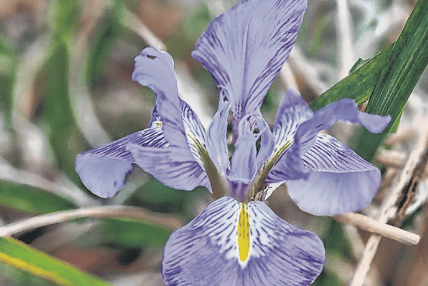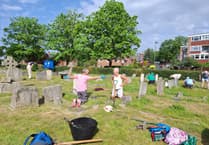Still lit up
What splendid news on the front of the January 25 issue of this paper: the word ‘‘Reprieved’’ writ large. Very large. The next line, not as large but very important, told readers that “Lightbox saved by government cash at 11th hour”.
Of course, I like to think that my piece, headed ‘‘The Hard-pressed Lightbox’’, for January 4 had something to do with it for, surely, the News & Mail is required reading for all civil servants and that job title includes MPs and all with moneybags within their reach. A nice thought but quite possibly an erroneous one, for there were plenty of cries for help for The Lightbox and they have been heard.
The phrase The Lightbox adopted at its start – Art Turned On, History Lit Up – can still ring true.
The news comes in the nick of time for a major exhibition opened on January 27: The Vanity of Small Differences, by Grayson Perry. It will run until June 2. This is an Arts Council Collection touring exhibition. Entry on a day pass is £9.50 but members of The Lightbox, and those under 18, get in free.
William Hogarth told the story, in the 18th century, of The Rake’s Progress in eight paintings telling of the decline and fall of Tom Rakewell. Perry covers his own 21st-century version of the story in six tapestries showing Rakewell embarking on a journey of modern social mobility.
Each tapestry measures 2m x 4m and portrays many of the characters, incidents and objects Grayson Perry encountered on journeys through Sunderland, Tunbridge Wells and the Cotswolds for the Channel 4 television series All in the Best Possible Taste.
For the same price you can visit another current exhibition which lasts until April 12. In I Dream a Palace Madi Acharya-Baskerville’s work responds to the site of Woking Palace, on the banks of the River Wey in Old Woking.
There are other galleries within The Lightbox, which are free to enter and marvel at, including Woking’s Story in which you may find much more about Woking’s Palace.
Search the sofa
Citizens Advice Woking (CAW) has also received some assistance. Justly so, as it is such an important giver of assistance and advice to those needing it.
Alongside The Lightbox it comes under Woking Borough Council’s six priority projects to which money has been reallocated from the government’s UK Shared Prosperity Fund.
I am pleased that CAW now have space in this newspaper to regularly put its case.
In my opinion it is a very worthy cause although I do realise that all this beneficence comes, ultimately, from the taxpayer.
And I am not alone in wishing I could put the whole thing in reverse to discover just where the blame for this monumental hole in WBC’s pocket started: just when did those threads start to wear and eventually unravel into a such a hole that the money just fell out and no one heard it hit the ground?
A splendid example of the proverb ‘‘a stitch in time saves nine’’. If only a seamstress or, perhaps, an auditor, had noticed the pocket starting to show signs of wear and get to the problem even before stitch one.
The usual reason for a pocket to give way is overloading. Children may carry conkers, stones, sticky sweets, interesting detritus picked up along the way.
Grown-ups should know better but was this the case of the WBC pocket? Overloading it with unwanted and useless items, however shiny and enticing they looked on the ground.
Perhaps some hearty rootling around down the side of the sofa will enable the saving of other worthy causes, such as the Bustler.
Thread count
The more threads there are to the square inch, the stronger the material.
WBC is asking the assistance of residents to help patch up that hole in the pocket and, obviously, the more stitchers, the better. The request is for groups to take over the running of assets owned by WBC.
I can see that many would be happy to help with gardening chores. But taking on the running of public conveniences? I am personally concerned about the conveniences on the Wheatsheaf Common, the annual site of the Horsell Scout & Guide May Fayre; would the Scouts have to hire portable loos for there must be loos with so many people, many being children, and the the fayre is a charity. There is a possibility of the grass on the Wheatsheaf not being cut prior to the fayre. Would such a chore come under the heading of gardening which could be undertaken by a willing group? Or would Health and Safety prevent such a solution?
My local residents’ association is requesting further information on the requirements for looking after public loos, concerning maintenance and repairs should a community group adopt servicing such a facility.
Decommissioning the loos solves little and just makes more problems for empty buildings will deteriorate and still require security patrols to check on them regularly for they will, surely, attract those anxious to be awarded the ASB – anti social behaviour award of dishonourable behaviour.
I would have thought that loos would have been one of those services which a council was required to keep going.
The continued threat to services which we have always taken for granted does focus the mind somewhat.
In the WBC’s plea for assistance I see that any help given by us, the taxpayers, will ‘‘allow the council o make essential budget savings and focus its resources on financing core services’’.
Shouldn’t the council have been doing that all this time? Or am I just being naive?
Lost opportunity
This paper was barely on sale before I received my first message concerning HG Wells' house.
Bridie Dolman told me that “a long time ago, before WBC had no money, suggestions for projects in the town were requested.
‘‘My offering was that the HG Wells home be bought and restored, getting rid of the alterations and uglifictions, so that it could become a small museum.”
She added, hopefully, that possibly there could yet be scope or this to happen.
Could be worse
Some 340 years ago England experienced what is sometimes reckoned to be the worst freeze since the Ice Age.
The Great Frost of 1683 to 1684 affected parts of Europe, not just us. Unfortunately exact temperatures were not recorded in the 17th century but it was recorded that the Thames not only froze over in London but it was covered with a foot of solid ice and stayed frozen for a couple of months. That would be the equivalent of having a major motorway out of action for that length of time.
We see the pretty picture side of this, with fairs on the ice, and oxen being roasted with no obvious effect on the ice. The last fair on the iced river was in 1814 and only lasted for four days. Since then, the Thames tideway has never frozen over.
What is not portrayed is the starving families, for not only was transport halted and obviously nothing could be transported on the waterways thus all those whose livelihood relied on river work were in a hopeless situation. No goods could be brought in from the countryside which was also frozen over, with cattle frozen to death and trees exploding with the cold.
Dr John Downes, a physician at Christ’s Hospital in London, issued his own daily temperatures measured in the town of -4C indoors and -12C outdoors. The lowest he recorded was -30C.
Another Great Frost hit much of Europe in the winter of 1708 to 1709, thought to be the coldest European winter for 500 years. In England the freeze lasted for three months and when the thaw came there was widespread flooding; a major catastrophe for what was then largely an agricultural economy.
In Upminster, William Derham recorded a low of -12C on the night of January 5, 1709, the lowest he had recorded since he started taking readings in 1697.
You will now understand the heading to this item – and give thanks for what we have today.
Un-sprung
Spring has not yet sprung but there is possibly, perhaps, just maybe, the tiniest hint that it is poised, ready to spring when light and warmth are just about right.
What made me think this way was the fall of a tree. For many years the tree had stood outside my garden. Dead. Not a twig, branch, bough or any bark bark left on it. Perforated with insect and bird holes it managed to stay upright through all the storms until Storm Henk brought it down, along with part of my fencing.
It doesn’t seem that long ago when the alphabetically named storms only got past the first few letters of the alphabet. And were given alternatively male and female names.
Take our recent storm Isha, which sounds like a local town; sometimes it is difficult to know whether a storm’s given name is male or female. I hope that comment does not arouse the ire of any storms! One does need to try to stay on the right side of the Clerk of the Weather.
How come Agnes was followed by Babet? Mind you, in 2016 we got as far as K for Kate. In this current season of storms we have got as far as ten of them since September.
Despite those storms, spring is definitely ruminating. I am certain of this for as we removed the broken fences we noticed the tops of the bulbs showing.
For a week or so now I have had a lovely pale mauve iris stylosa aka the Algerian iris, in flower, and some snowflakes are in bud, although the snowdrops are still hiding.
Cuckoo pint leaves are pushing through the debris. The forsythia, broken by the fence, will come to flower in a vase: the buds are showing already.
So wait for it! The beginning is nigh!



.jpeg?width=209&height=140&crop=209:145,smart&quality=75)

Comments
This article has no comments yet. Be the first to leave a comment.